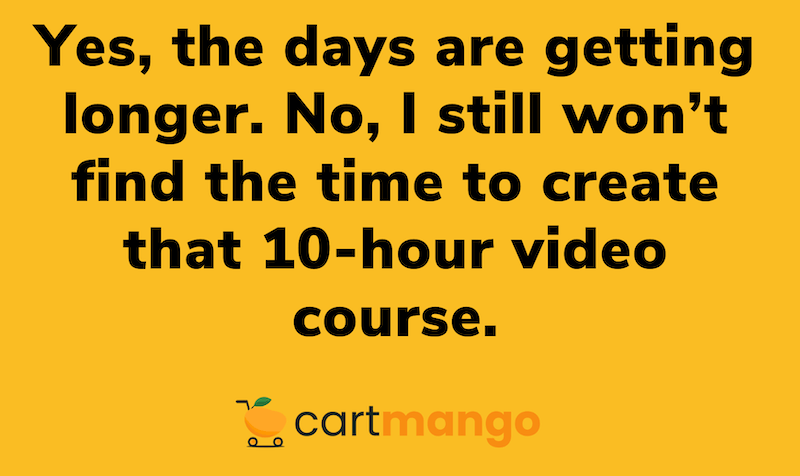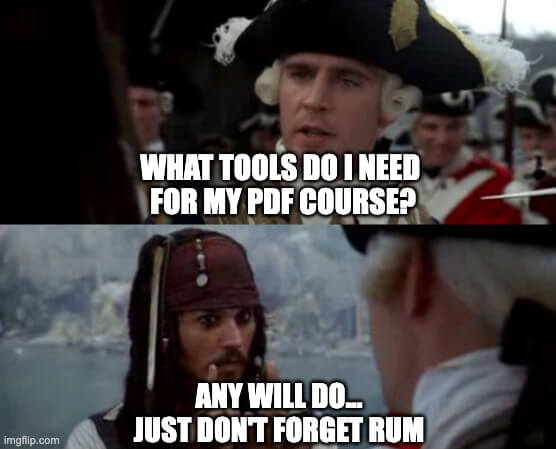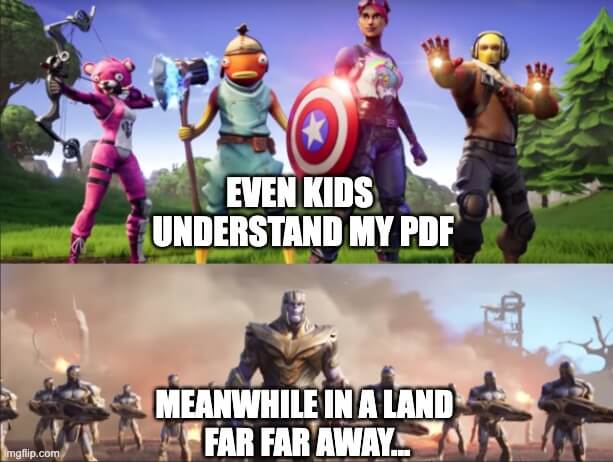I get that creating full-blown online courses is no easy task.
That’s why delivering your course in PDFs could be your answer to creating your first online course. I’d even wager it’s the fastest way to create an online course.
What about video courses? Nahhh…

PDFs are great because they’re easy to use, share, and students can refer to them anytime they wish. In this blog post, I’ll show you how to create a useful online course pdf that will set you apart from others.
Step 1: Plan Your Online Course Creation PDF

Before you create your course, plan.
First, what will you teach? Choose a topic you know well and love. Also, what do people want to learn right now so your course is relevant.
Next, who is your course for? Who will benefit most from it? Knowing this will help you tailor your course to them. What is their age range? What are their professions? What do they want to learn? What problems do they want to eliminate?
Third, write down your online course outline. Break down your topic into sections or modules. This serves as the foundation of your PDF. Start broadly and drill down into subtopics. Include practical exercises or case studies to reinforce learning. Use templates and workbooks to help you and your students create an outline for your course together.
Finally, list out what you’ll cover in your course materials. Break down your topic into smaller chunks. This will help you structure your PDF.
Also add real life examples to help folks better understand key concepts and lessons in their learning journey.
Remember, it’s totally ok to feel overwhelmed. Just make sure to take it one step at a time.
Step 2: Pick your tools

To create a professional-looking PDF, you’ll need the right tools. Here are some:
Writing tools
Microsoft Word and Google Docs are good for writing your pdf course. They’re easy to use and quick to create.
If you want something fancier, try tools like Scrivener or Vellum.
Graphic design app
If you want to add eye-catching visual elements, try Canva or Adobe InDesign. Canva is for beginners, while InDesign is for those with design experience.
PDF editing software
Adobe Acrobat is the gold standard for PDF editing but it costs money. There are free options too like PDFescape or Smallpdf that can do basic editing.
These tools let you add interactive elements, change how things look, and make your PDF looks professional.
Step 3: “Beautify” your online course PDF
A nice looking PDF will make your course more fun and easier to understand. Here are some tips:
1/ Create a nice layout:
Keep it clean and consistent throughout so it’s easy to read and scan.
2/ Use consistent branding and design elements:
Put your logo, brand colors, and fonts in the PDF.
This will make it look professional and remind people it’s YOUR course.
Choose easy to read fonts and maybe use bigger or different styles for titles.
3/ Add clickable elements

Make your PDF more interesting by adding links to other useful stuff, buttons to navigate or even video content if you can. This will make it more fun than just reading.
4/ Use good graphics:
Pictures can help explain things.
Use clear high quality images and make your own drawings or charts to illustrate tricky concepts. If you use images from the internet make sure to credit them.
Step 4: Choose your PDF type
For your online course PDF you can create:
Course outlines and syllabi:
These tell students what your course is about and what to expect, so everyone is on the same page. I also suggest letting them know of any prerequisites (if any).
Workbooks and worksheets:
What better way to apply what they’ve learned by asking them to fill out workbooks/worksheets. Include plenty of space for them to write their answers and thoughts.
Checklists and how-to guides:
These help students quickly remember what to do. Break big tasks into easy steps they can follow in your online course pdf checklist.
Video transcripts:
These are good for people who like to read or want to go over stuff without watching the video lessons again. Add time markers so they can find specific parts easily in your online course pdf transcript.
Slide handouts:
Create presentation slides that sum up important points and help explain things. Turn your slides into a PDF so students can review any time they wish.
Additional resources:
These give more information about your course topics. Make a list of helpful articles, books, or research that goes with your course.
Step 5: Follow these tips for creating good course PDFs
To make your course PDF as good as possible follow these:
Write clearly: Use simple language and no jargon. Break up long paragraphs into shorter ones. Using examples and metaphors can help too.
Use visuals to explain: Include images, diagrams or infographics to illustrate tricky concepts. Visuals can break up text and cater to different online learning styles.
Format and organize: Use headers, sub-headers and bullets to make sure you have a good content structure. Consider a table of contents for longer PDFs so students can navigate the doc easily.
Proofread and edit: You want to make sure there are not grammatical errors or typos. If you have the budget, you might want to hire a professional editor or proofreader.
Include practical exercises: Include activities, quizzes or reflection questions throughout your PDF to reinforce online learning and get students to engage with the content.
Step 6: Making your PDF interactive

While PDFs are static documents, there are ways to make them more interactive:
Add links: Students can click these links to enhance their learning experience.
Add multimedia: Some PDF formats allow you to embed audio or video files into the document. This can be useful for demonstrating techniques or providing extra explanation. Just make sure to use proper formatting so it’s easy to consume.
Create fillable forms and quizzes: Use PDF editing software to create interactive elements that students can fill in within the document. This can be multiple choice questions, text fields for short answers or checkboxes for completion tracking.
Use layered PDFs: Create PDFs with multiple layers that students can toggle on and off. This can be useful for revealing answers to exercises or extra information on demand.
Step 7: Making it easily accessible

Make your PDF easy to read and scan: Use proper heading structures and alt text for images… so that visually impaired students can navigate your document and understand the content of images.
Font sizes and colors: Use fonts that are easy to read. Also make sure to have enough contrast between text and background colors.
Offer alternative formats: Consider providing your course content in multiple formats (e.g. text, audio, video) to cater to different learning preferences and needs.
Step 8: Publishing & sharing your online course PDF
Once your PDF is ready you’ll need to decide how to share it:
Choose where you want to “house” the PDFs: Some options are Google Drive, Dropbox, or your own site to host them. Make sure to consider from a security and accessibility standpoint too
Add PDFs to your learning management system (LMS) platform: If you’re using an LMS like Teachable or Thinkific you can upload PDFs directly to your course modules. This lets you track student progress and engagement with the content.
Consider digital rights management (DRM): If you’re worried about your PDF being shared without permission, look into DRM options to protect your intellectual property.
Step 9: Marketing your online course PDF

Having a great course PDF is only half the battle. You also need to get it in front of your target audience, most likely using digital marketing:
Build a sales page: Sell the benefits of your course and include testimonials if you have them. Use copywriting techniques to showcase the value of your course.
Use SEO: Use keywords in your course description and metadata for higher search engine rankings. Create blog posts around your core topic to drive organic traffic.
Use social media and email marketing: Share bits of your course content to generate interest and build an email list to reach students directly. Use Instagram or LinkedIn to showcase your expertise and attract students.
Offer a free sample: Consider creating a shorter version of your PDF as a lead magnet to attract students and give them a flavour of your teaching style.
For a more comprehensive marketing strategy, go here.
Step 10: Consider online piracy effects for your course PDFs

We touched on this earlier under Digital Rights Management. But let’s go a level deeper. Online piracy is a big problem for course creators. According to Digital Citizens Alliance, online piracy costs the US economy $29.2+ billion in lost revenue every year.
Online piracy is a big problem everywhere:
In 2023 people visited piracy websites 141 billion times, that’s 386 million times a day.
Pirated videos get over 230 billion views a year.
20% of the world’s internet bandwidth is spent on streaming, uploading and downloading pirated content including educational content and PDFs.
To combat this course sellers should consider watermarking their PDFs.
Watermarking means embedding a visible mark on the document to identify the creator and deter sharing. This is a simple and effective way to protect your intellectual property.
Another way is to use a cart/checkout tool like CartMango that automatically protects the customer download area. This means only paying customers can access the download area and not unauthorized users can access your PDFs. Implementing this reduces the risk of piracy and protect your content.
Free templates
To get you started here are some freebies:
These will save you time and give your PDFs a professional look from the get go. Customize them as you see fit.
What next?
So that’s how to create an online course PDF. Follow the steps above and just actually “do it”. No more ifs. No more buts. Do it, get feedback, and improve. That’s how you win in anything really.
We both know Rome wasn’t built in a day. So you shouldn’t expect to create your online course pdf magically out of thin air.
Sell your online course PDF using CartMango
Once you’ve created your PDF downloadable, why not give CartMango a free try? With a focus on boosting sales conversions for course creators with 1-10 teammates, I’m pretty sure you’ll like it (unless sales ain’t your thing). Try CartMango free here.
Sources
Click to see
Imgflip for the memes
Related reading
- Abandoned cart email templates
- What are digital products
- Affiliate marketing statistics
- Online course ideas
- How to price your online course
- Video hosting platforms for your course
- Where to source your digital products
- 7 Steps to high ticket selling
- What is digital publishing
- LinkedIn post preview tool
- Solopreneur coaching
